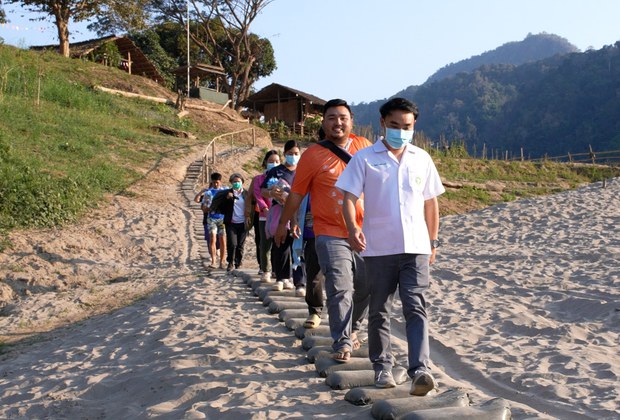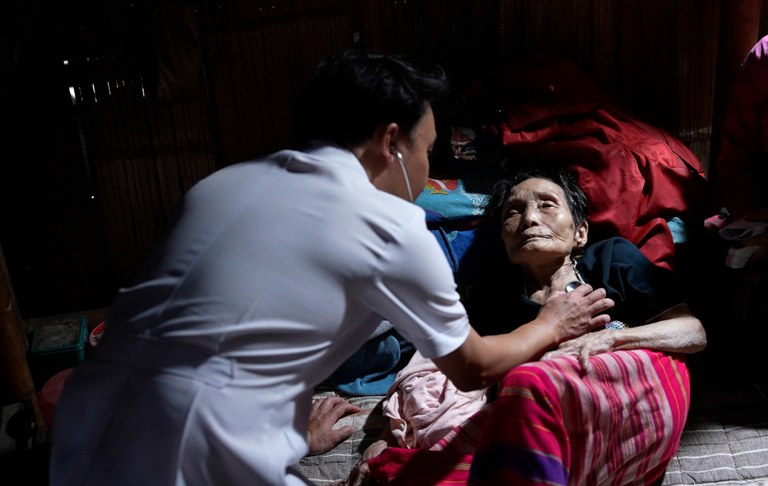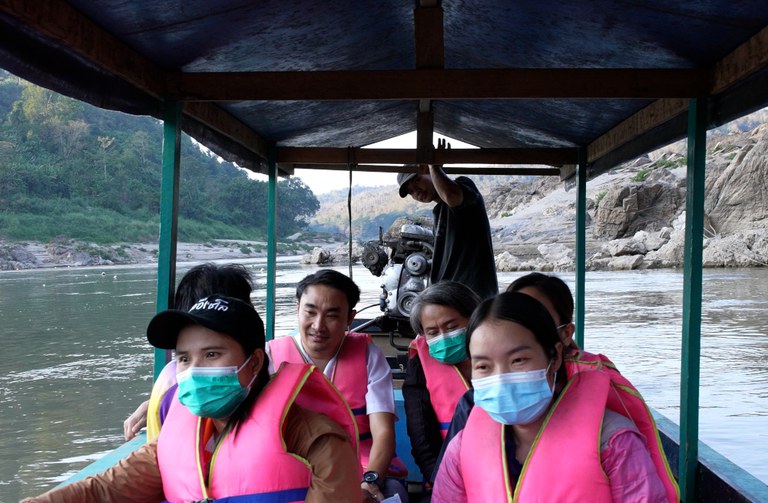Thailand’s rural doctors venture to remote places, push for health-care equality
2025.03.25
Mae Hong Son, Thailand, and Bangkok
 Physician Pittaya Lhawong, director of Sop Moei Hospital in Thailand’s Mae Hong Son province, travels with a public health team to examine patients in Mae Hong Son province near the border with Myanmar, Feb. 20, 2025.
Physician Pittaya Lhawong, director of Sop Moei Hospital in Thailand’s Mae Hong Son province, travels with a public health team to examine patients in Mae Hong Son province near the border with Myanmar, Feb. 20, 2025.
Physician Pittaya Lhawong often travels far and wide from his hospital to make house calls and treat patients in remote corners of Mae Hong Son province.
He’s among a younger generation of doctors who have taken up the mantle of keeping Thailand’s decades-old Rural Doctors Movement going.
Their mission is to deliver medical care to places that are hard to reach and to bridge health-care disparities between urban communities and underserved populations across the countryside.
“We see senior doctors in the Rural Doctors Movement who have worked tirelessly for many years. They inspire us,” Pittaya, the 40-year-old director of the Sop Moei Hospital in Mae Hong Son, told BenarNews.

He has 20 years left before retirement, but says he remains committed to working as a doctor in the countryside, where salaries for doctors aren’t as high as in the big cities. He’s dedicated himself to helping ensure that people in remote villages receive adequate health care.
“There is a huge gap in access to health care between urban and rural areas, and I want to be part of the effort to close it,” Pittaya said.
His dedication isn’t unique.
Many young doctors choose to serve in rural areas, following the footsteps of generations of rural health care providers who laid the groundwork for Thailand’s public health system.
Shortages
Still, Thailand has long struggled with a shortage of doctors in rural areas. Among the most problematic areas are Mae Hong Son and Tak provinces along the border with Myanmar, and Nong Khai and Bung Kan provinces along the border with Laos.
Thailand has a total of 78,418 doctors with less than half – 37,808 – working outside of Bangkok. About 5,000 doctors work at 780 smaller district hospitals, according to the Medical Council of Thailand.
As the numbers reflect, over the decades, many medical graduates preferred working in urban hospitals or moving abroad for better salaries.
RELATED STORIES
Thai hospital near Myanmar border treats dozens injured in Kayin fighting
Thailand delivers first aid shipment to Myanmar via new humanitarian corridor
Asia battles surge in dengue cases amid fears of record infections worldwide
To address this, the Ministry of Public Health implemented a scholarship program requiring medical students to serve at least three years in rural hospitals after graduation. Despite increased numbers of medical graduates, rural hospitals still face staffing shortages.
“Today, more doctors are being trained than before, but fewer choose government service or rural assignments,” Dr. Pittaya said.
“Many opt for private hospitals or cosmetic clinics in the city, which offer better salaries and work-life balance. Some doctors enjoy their rural assignments and stay, but others move on quickly. That’s their right, but it does make rural health care a persistent challenge.”
Doctors who work in the public sector across the nation are paid 40,000 baht to 60,000 baht (U.S. $1,200 to $1,800) per month, while specialists receive additional stipends.
By comparison, doctors working at private hospitals can see starting salaries from 80,000 baht to 140,000 baht ($2,400 to 4,200).

In April 1976, the Rural Doctors Movement was established as the Rural Doctor Society to address this issue. The goal of present-day members of the network is to ensure that even the most isolated communities have access to medical services, with senior doctors often serving as mentors to younger physicians and encouraging them to stay in rural areas.
“We are like watchdogs for the public health care system, ensuring that taxpayer money reaches the people who need it most, especially those in remote areas,” said physician Wichai Chokwiwat, a former president of the movement.
In recognition of its impact, the Rural Doctors Movement received the Ramon Magsaysay Award, Asia’s equivalent of the Nobel Prize, in 2024.
“Their work has yielded tangible, lasting results. They have shown that accessible, high-quality health care is fundamental to social justice, that democracy plays a key role in fostering systemic change, and that selfless service can lead to extraordinary outcomes,” the award citation stated.
For those involved in the movement, the recognition is a validation of their lifelong commitment to health care equity.
Pittaya recalled one particular case that reinforced his dedication to the cause.
“We could deny treatment to undocumented migrants who cross the border, but we don’t. A patient’s life is a life,” he said.
“What if he is the sole provider for his family? If we refuse treatment and he becomes permanently disabled, his entire household suffers. We always prioritize care first and deal with paperwork later.”
Providing medical care in remote regions is a daunting task. Many communities lack basic infrastructure including electricity and the internet. In some cases, patients must travel hours to be treated, depending on road conditions.
“In Sop Moei, patients have to travel on dirt roads for four hours to reach the nearest subdistrict hospital. In the rainy season, it can take even longer. That’s why we bring medical care to them instead,” Pittaya said.
“We make house calls to bed-bound patients, distribute medicine and ensure that people receive the health care they deserve.”
Despite the hardships, rural doctors say they feel fulfilled in their work.
“When you see the smiles of the people you help, you know you’re making a difference,” Pittaya said. “At the end of the day, that’s what keeps us going.”







